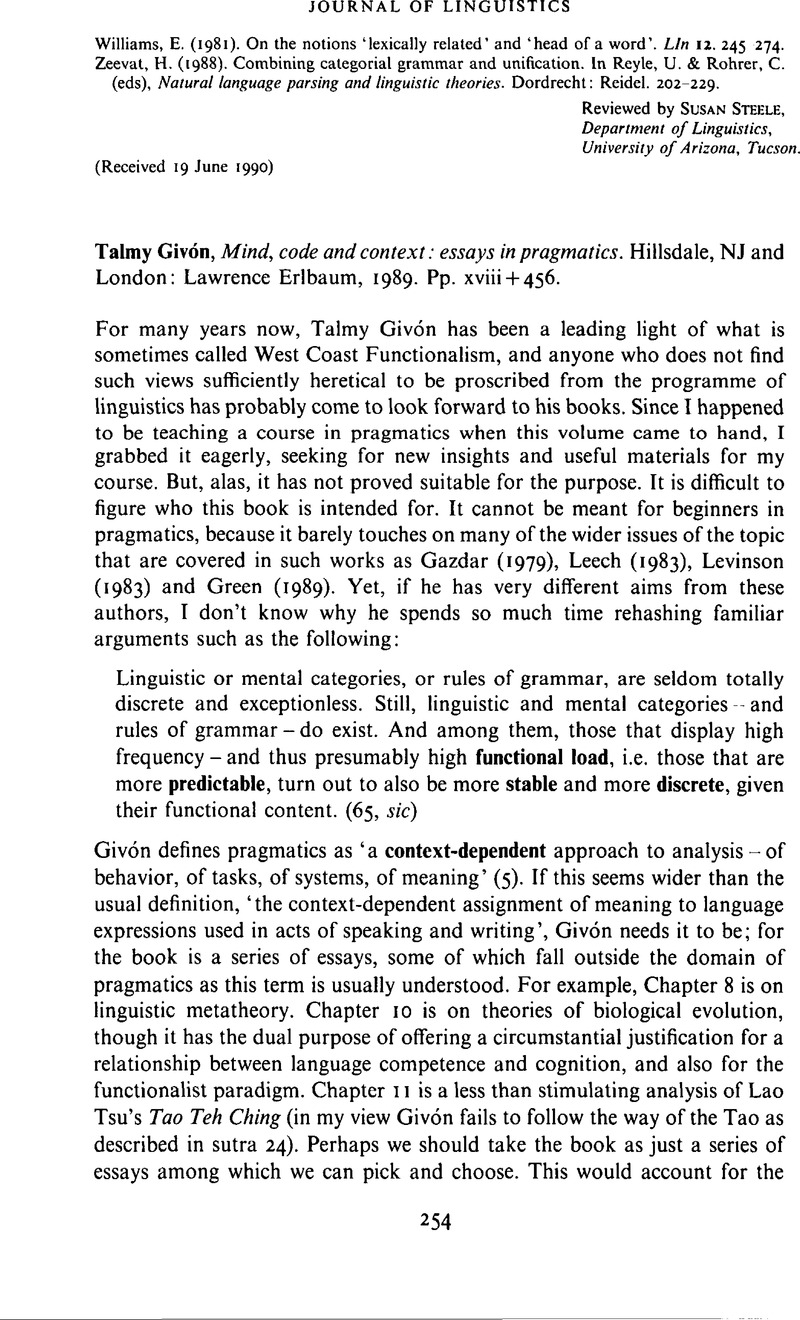No CrossRef data available.
Article contents
Talmy Givón, Mind, code and context: essays in pragmatics. Hillsdale, NJ and London: Lawrence Erlbaum, 1989. Pp. xviii + 456.
Published online by Cambridge University Press: 28 November 2008
Abstract
An abstract is not available for this content so a preview has been provided. Please use the Get access link above for information on how to access this content.

- Type
- Reviews
- Information
- Copyright
- Copyright © Cambridge University Press 1991
References
REFERENCES
Allan, K. (1987). Hierarchies and the choice of left conjuncts (with particular attention to English). JL 23. 51–77.CrossRefGoogle Scholar
Chafe, W. L. (1976). Givenness, contrastiveness, definiteness, subjects, topics and point of view. Subject and Topic, Li, Charles N. (ed.). New York: Academic Press. 25–55.Google Scholar
Chafe, W. L. (ed.) (1980). The pear stories: cognitive, cultural and linguistic aspects of narrative production. Norwood, NJ: Ablex. 9–50.Google Scholar
Craig, C. (ed.) (1986). Noun classes and categorization. Amsterdam & Philadelphia: John Benjamins.CrossRefGoogle Scholar
DuBois, J. (1980). Beyond definiteness: the trace of identity in discourse. In Chafe, W. L. (ed.), The pear stories: cognitive, cultural and linguistic aspects of narrative production, Norwood, NJ: Ablex. 203–74.Google Scholar
Gazdar, G. (1979). Pragmatics: implicature, presupposition, and logical form. New York: Academic Press.Google Scholar
Givón, T. (ed.) (1983). Topic continuity in discourse: a quantitative cross-language study. Amsterdam & Philadelphia: John Benjamins.CrossRefGoogle Scholar
Givón, T. (1984). Syntax: a functional typological introduction, vol. 1. Amsterdam: John Benjamins.CrossRefGoogle Scholar
Green, G. (1988). Pragmatics and natural language understanding. Hillsdale, NJ: Lawrence Erlbaum.Google Scholar
Haiman, J. (ed.) (1985). Iconicity in syntax. Amsterdam & Philadelphia: John Benjamins.CrossRefGoogle Scholar
Prince, E. (1981). Toward a taxonomy of given-new information. In Cole, P. (ed.), Radical Pragmatics. New York: Academic Press. 233–256.Google Scholar
Rumelhart, D. E. & McClelland, J. L. (eds) (1986). Parallel distributed processing. Explorations in the microstructures of cognition (2 vols): Foundations. Cambridge MA: MIT Press.CrossRefGoogle Scholar
Schank, R. (1982). Dynamic memory: a theory of reminding and learning in computers and people. Cambridge: Cambridge University Press.Google Scholar
Sperber, D. & Wilson, D. (1986). Relevance: communication and cognition. Oxford: Basil Blackwell.Google Scholar




